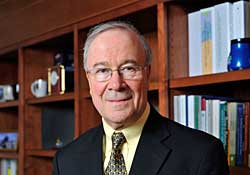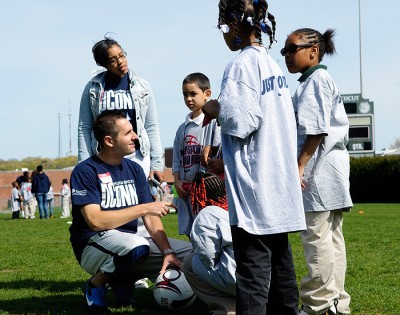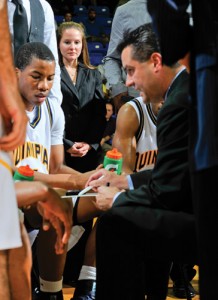 Accolades – below are news and notes from our alumni, faculty, staff, and students. We are proud of all the amazing accomplishments by our Neag family. If you have an accolade to share, we want to hear from you! Please send any news items (and story ideas) to shawn.kornegay@uconn.edu.
Accolades – below are news and notes from our alumni, faculty, staff, and students. We are proud of all the amazing accomplishments by our Neag family. If you have an accolade to share, we want to hear from you! Please send any news items (and story ideas) to shawn.kornegay@uconn.edu.
PROGRAMS
Husky Sport was one of 13 organizations recognized with a 2011-2012 Extended Schools Hours Grant Program from the Hartford Public Schools. Extended School Hours Programs are intended to provide opportunities for academic improvement, which include the provision of instructional services to help students meet state and local performance standards.
ALUMNI
Maurice Doolittle (B.S. physical therapy ‘65) has retired after working as a physical therapist in five different states. He is looking forward to his retirement in Louisiana with his wife, Sunnie.
Craig Esposito (Ph.D. educational administration ‘10) won a spot on the Town of Stonington’s school board.
Theresa (Dombrowski) Forbes (B.S. elementary education ’97, M.A. curriculum and instruction ’98, Sixth-Year Certificate in educational psychology ’05) and Sean Forbes announce their marriage on July 16, 2011, in Manchester, Conn. Theresa is a teacher in Glastonbury, Conn.
Greg Fuller (B.S. sport science ’97) and Nicole (Perras) Fuller ’98 (RHSA) announce the birth of their second child, Evan, on July 15, 2010. He joins older brother Jackson, 4.
Carol (Ewing) Garber (B.S. recreational service education ’75, M.A. sport and leisure studies ’83, Ph.D. sport and leisure studies ’90) is associate professor of movement sciences and education at Teachers College, Columbia University in New York, N.Y. She serves as vice president of the American College of Sports Medicine. She recently returned to campus as a guest speaker.
Bridgette Gordon-Hickey (M.A. in special education ‘05, Sixth-Year Certificate in educational administration ‘08), associate director of Regional Multicultural Magnet School (RMMS) in New London, was selected as the 2012 CAS Elementary School Assistant Principal of the Year.
Allen R. Jones Jr. (B.S. physical therapy ’87) opened Dominion Physical Therapy & Associates’ seventh office, in Norfolk, Va. Dominion specializes in sports, work, and personal injuries.
Marianne Kennedy, Southern Connecticut State University’s Interim Provost, served as the lead campus administrator until Southern’s new President, Mary Papazian, arrived on February 1. During her 17-year career as a faculty member, department chairwoman and administrator at Southern, Kennedy has attained a wealth of institutional knowledge and earned a reputation as an active scholar, an excellent communicator, and an effective collaborator. Kennedy earned her Ph.D. in special education from the Neag School in 1994 and joined Southern’s Communication Disorders Department in 1994.
Peter MacGillis (B.S. in exercise science ’93, MBA ’98) was featured on the Travel Channel’s “Man v. Food Nation” on Aug. 18, 2011.
Race issues, the role of the media in 21st century politics and public perceptions of President Barack Obama’s communication style are all examined in a recently published book by Dr. Mark P. Orbe (M.A. in professional higher education and administration ’90), Western Michigan University professor of communication. “Communication Realities in a ‘Post-Racial’ Society: What the U.S. Public Really Thinks About Barack Obama” was published by Lexington Books. The first book its kind, it draws from a large national qualitative data set generated by 333 diverse participants from 12 different U.S. states across six regions and provides comprehensive, in-depth coverage of the similarities and differences that exist among diverse groups of everyday Americans.
Louise Tarnowski Plack (B.S. elementary education ’84, M.A. special education ’90) is a special education teacher at Marlborough Elementary School and executive board member of Pocketful of Joy, a nonprofit organization that provides health care and education opportunities to children in northern Tanzania. From January to March 2011, she worked in Tanzania with educators at the local and district level to improve education for primary and secondary schoolchildren.
The Future of Diplomacy Project at the John F. Kennedy School of Government, Harvard University, announced that Tim Shriver, president and CEO of Special Olympics, is a 2012 Fisher Family Fellows. Shriver earned his Ph.D. in Education from the Neag School.
Lois Greene Stone (B.S. ’55) and her husband, Dr. Gerald E. Stone, celebrated 55 years of marriage and welcomed their 15th grandchild this spring. Lois, a writer and poet, is syndicated worldwide.
Tiffany Violette (B.A. journalism, sociology ‘93; Sixth-Year Certificate in educational administration ‘02) associate principal of South Windsor High School was named the 2012 CAS High School Assistant Principal of the Year.
James Zullo (B.S.’66) retired as a high school basketball coach in New York with 528 wins.
Several English Education Neag graduates and students traveled to Chicago in November to participate in the 2011 Workshop of the Assembly on Literature for Adolescents of the National Council of Teachers of English.
- Ricki Ginsberg (Rockville High School, Vernon) and Tiffany Smith (Parish Hill High School, Chaplin) presented a breakout session entitled, “Forging Ahead: Proposing, Designing, Teaching and Defending a High School Young Adult Literature Elective.” Ricki also serves as an elected Director on the ALAN Board.
- Kelly Thurston (Francis T. Maloney High School, Meriden) and Ethan Warner (O.H. Platt High School, Meriden) shared their expertise in a panel, “Using YA Literature to Bridge the Gap for Male Readers.”
- Cleo Rahmy (Portland Middle School), Emily Hernberg (New Canaan High School), and Claire Peyser (Westwood High School, MA) examined the challenges faced by teachers new to the profession in their presentation, “Young Adult Literature As A First-Year Teacher: A Second-Year Retrospective.”
- Danielle King (East Hampton High School) chaired an author panel entitled, “Middle grade titles: In those in-between spaces.”
- Elizabeth Stagis (East Hartford High School) was named the 2011 recipient of a Gallo Grant awarded to a talented early career teacher for attendance at his/her first ALAN Workshop.
Mike Hurst (West Hartford Middle School) and Marisa Ives (UConn) were both first-year attendees who represented UConn well with their passion and professionalism.
FACULTY
The University’s Research Advisory Council selected the following Neag faculty members as Fall 2011 Faculty Large Grant Award recipients:
- Michael Faggella-Luby, Project VISIBLE: Validating Implementation of Secondary Instructional Behaviors in Literacy & English, $24,898
- Lisa Sanetti, Evaluation of a Planning Protocol on Teachers Implementation of a Classroom Management System in an Alternative School Setting: A Pilot Study, $24,966
- Megan E Welsh, Validation of Student Learning Objectives as a Teacher Evaluation Tool, $22,084
The Dept. of Kinesiology hosted Neil Walsh, Ph.D., head of research at Bangor University’s School of Sport, Health & Exercise Sciences, as a four-week guest professor. Dr. Walsh provided two university-wide lectures and had opportunities to interact with both students and staff through small group seminars, lectures, presentations and research discussions. Dr. Walsh’s visit was under the auspices of the Guest Professor award program, Office of the Vice President for Research.
The Neag School welcomed high school teachers and administrators from Shuicheng, Shandong Province in China, who were here visiting with teachers and administrators in Haddam-Killingworth School District (Region 17). Shandong is Connecticut’s ‘sister province’ and we have been entertaining visitors from Shandong for many years.
Steven Adamowski, who is the former superintendent of the Hartford Public Schools, is joining the EDLR department in the Executive Leadership Program working with Bob Villanova.
Lawrence Armstrong and Richard Schwab were elected as Faculty At-Large to UConn’s University Senate. Schwab was also elected to the Faculty Review Board.
Scott Brown was a co-author on two recent publications, Expanding the science and writing curricular space: The GlobalEd2 Project and Impacting middle school students’ science knowledge with problem-based learning simulations, for the IADIS International Conference Cognition and Exploratory Learning in Digital Age (CELDA). He also participated in the following presentations: “Impacting middle school students’ science knowledge with problem-based learning simulations”, IADIS International Conference Cognition and Exploratory Learning in Digital Age, Rio de Janeiro, Brazil; “Impacting science knowledge through an educational game: The GlobalEd2 Project” Northeastern Educational Research Association Conference, Rocky Hill, CT; “Intention-based web browsing: Characteristic browsing patterns of student inquiry” Northeastern Educational Research Association Conference, Rocky Hill, CT.
Doug Casa is being inducted into the University of Florida Alumni Hall of Fame in April.
Tutita Casa had an article published in the NCTM journal Teaching Children Mathematics entitled “Connecting class talk with individual student writing.” The article was published with one of her former students and an intern who worked on the Project M2.
Craig Denegar, Maryclaire Capetta and Nancy Craven were recently elected as officers for the CT Physical Therapy Association. Denegar is president, Capetta is chief delegate and Craven is secretary.
Odvard Egil Dyrli, emeritus professor of curriculum and instruction in the Neag School of Education, was elected to a third four-year term on the Board of Trustees of Messiah College, Grantham, Pa. Dyrli serves on the executive council, chairs the education committee, and is on the steering committee for re-accreditation by the Middle States Commission on Higher Education.
M. Kathy Gavin received the Distinguished Alumna Award from Emmanuel College, Department of Education (May 2011). She also had a book in the Practical Strategies Series in Gifted Education entitled Identifying and Nurturing Math Talent published by Prufrock Press.
M. Kathy Gavin, Tutita Casa, Suzanne Chapin, Linda Sheffield, Janine Firmender & Catherine Osiecki received the National Association for Gifted Children Outstanding Curriculum Studies Award for the Project M2 unit, Exploring shapes in space: Geometry with Imi and Zani.
Robin Grenier was elected to the Academy of Human Resource Development Board for a three-year term. AHRD is a global organization made up of, governed by, and created for the Human Resource Development (HRD) scholarly community of academics and reflective practitioners and has over 500 members worldwide.
Jason Irizarry was one of two featured speakers at the CSDE and SERC 2011 Black & Hispanic/Latino Male Statewide Forum, held in December at Central Connecticut State University.
Tom Kehle was awarded the Outstanding Contribution to Training by the National Association of School Psychologists. He was recognized at the NASP National Awards Lunch in February.
Catherine Little, Sherryl Hauser, & Jeffrey Corbishley received the Linking Research and Practice Outstanding Publication Award – Mathematics teaching in the middle school, for article “Constructing Complexity for Differentiated Learning,” from the National Council of Teachers of Mathematics.
Melissa Madaus was invited to submit an online article for Psychology in the Schools with her graduate assistant, Laura Ruberto. The article “Application of self-modeling to externalizing and internalizing disorders” appeared online in Dec.
Joseph Madaus was just elected vice president of the Division on Career Development and Transition, which is a chapter of the Council for Exceptional Children. It’s a four-year term – one year as VP, one as President-Elect, one as President, and one as Past-President.
Alan Marcus has been awarded an Office of Global Programs Global Partnerships Faculty Travel Grant for his project “Developing Global Citizens: Teacher Education and Museum Education in the US and the US.” The award is intended to deepen and expand existing relationships with our international partners in a larger effort to help internationalize our university.
Betsy McCoach and Del Siegle have been selected as the next co-editors of Gifted Child Quarterly, NAGC’s scholarly journal beginning with the winter 2013 issue. (2013-2017).
Linda Pescatello and Blair Johnson have conducted a series of meta-analysis resulting in three publications in the literature and one out this month on exercise and cancer – “Exercise interventions for cancer survivors: A meta-analysis of quality of life outcomes” Ann Behav Med; “Efficacy of exercise interventions in modulating cancer-related fatigue among adult cancer survivors: a meta-analysis” Cancer Epidemiol, Biomarkers; and “The efficacy of exercise in reducing depression among cancer survivors: A meta-analysis” PLoS ONE.
Joe Renzulli was the keynote speaker on “Nurturing Creative Talent in High School Students.” The conference was sponsored by East China Normal University, Shanghai, China. He was also the keynote speaker on “A Technology Based Program That Matches Enrichment Materials With Individual Student strength Areas” for the International Center For Innovation In Education, Dubai, United Arab Emirates.
Yuhang Rong is the chair of the AACTE Global Diversity Committee, effective Feb 16, 2012 through Feb 2013. He also served as a panelist on “The Policy and Politics of Global Teacher Education” for AACTE in Chicago.
Sue Sanders has been appointed a director of professional development for the ACPA-College Student Educators International. American College Personnel Association, headquartered in Washington, D.C. at the National Center for Higher Education, is the leading comprehensive student affairs association that advances student affairs and engages students for a lifetime of learning and discovery.
Del Siegle received the 2011 NAGC Service Award from the National Association for Gifted Children.
Brandi Simonsen and George Sugai published an article in the recent edition of the Journal of Positive Interventions, “Schoolwide PBS ‘Hi-Fi’ “. Simonsen also co-published an article “Don’t Forget” with Aimee Faul (IB/M alumnus) and Karoline Stepensky (IB/M alumnus) in the same journal.
Diane Ullman who is the superintendent of the Simsbury Public Schools and received the Superintendent of the Year Award from the Neag Alumni Society is retiring from her current position and will be working in a similar capacity as Bob Villanova. She will become director of UCAPP and continue her involvement in the ELP program.
Michael Young has been elected to the Board of Education for the Town of Ellington.
STUDENTS
Janine Firmender and Lisa Rubenstein each won a 2011 Doctoral Student Award at the National Association for Gifted Children.
Kendrick Henes, a secondary science major, has been invited by Liz Buttner of the State Department of Education to serve on the committee reviewing drafts of the Next Generation Science Education Standards – the only student pre-service teacher to serve in CT and nationally.
Nicole LaPierre and Melanie Rodriguez would like to thank everyone who “liked” the photo on Facebook of Clark Elementary and Middle Academy. They won the “We Give Books” contest and will now receive a library of books for Clark School in Hartford! They are renovating and reopening the currently closed school library in Clark for their Masters Inquiry Project and these books will help immensely. They are appreciative of the support.
Melissa Collier Meek who was awarded a $500 professional development award due to her excellent scholarly record. She was selected as a recipient of Pearson/Trainers of School Psychology Professional Development Scholarship for graduate students.
Jessica Raugitinane is a recipient of the Alma Exley Scholarship and will be recognized in May.
Kim Adler, from Westport, CT, was a participant in the 2011 Mentor Connection program and she worked with Dr. Cynthia Peterson, a professor of physics. She competed in a local science fair, Southern Connecticut Invitational Science and Engineering Fair, and won first place for a physical science project. She will be presenting at the JSHS in March at UConn.
 On behalf of the Neag School of Education’s Alumni Society, we invite you to participate with the below survey. It will only take a few minutes. We will use this information to provide better communication and to better serve our alumni and frieinds. Your feedback and input is greatly appreciated. We’ll also have a drawing for a free Neag Swag Bag or a $25 Starbuck giftcard for those who participate (you must provide your email at the end to have a chance in the drawing). Deadline to respond to the survey is Thursday, April 12. Thank you!
On behalf of the Neag School of Education’s Alumni Society, we invite you to participate with the below survey. It will only take a few minutes. We will use this information to provide better communication and to better serve our alumni and frieinds. Your feedback and input is greatly appreciated. We’ll also have a drawing for a free Neag Swag Bag or a $25 Starbuck giftcard for those who participate (you must provide your email at the end to have a chance in the drawing). Deadline to respond to the survey is Thursday, April 12. Thank you! Peter J. Nichols, Ph.D., UConn’s provost and executive vice president for Academic Affairs, has served in major academic leadership roles for the past 20 years. He is the University’s chief academic officer and is responsible for all academic programs, including the regional campuses, School of Law and schools of Medicine and Dental Medicine. Reporting to him are deans of the schools and colleges, along with other high-level academic leaders, such as the vice president for Student Affairs. He’s had a long, successful career in administration and seven successful years at UConn as provost, but something else was calling him–a desire to return to teaching and research.
Peter J. Nichols, Ph.D., UConn’s provost and executive vice president for Academic Affairs, has served in major academic leadership roles for the past 20 years. He is the University’s chief academic officer and is responsible for all academic programs, including the regional campuses, School of Law and schools of Medicine and Dental Medicine. Reporting to him are deans of the schools and colleges, along with other high-level academic leaders, such as the vice president for Student Affairs. He’s had a long, successful career in administration and seven successful years at UConn as provost, but something else was calling him–a desire to return to teaching and research. Establishing “Innovation Funds” for community partnerships that enhance learning, creating professional development programs more aligned with federal education expectations, and establishing new frameworks for teacher evaluations are among the ways states awarded Race to the Top (RTT) grants have begun to used their share of the $4 billion given by the federal government in 2011 to improve K-12 school quality and effectiveness.
Establishing “Innovation Funds” for community partnerships that enhance learning, creating professional development programs more aligned with federal education expectations, and establishing new frameworks for teacher evaluations are among the ways states awarded Race to the Top (RTT) grants have begun to used their share of the $4 billion given by the federal government in 2011 to improve K-12 school quality and effectiveness. The
The 

